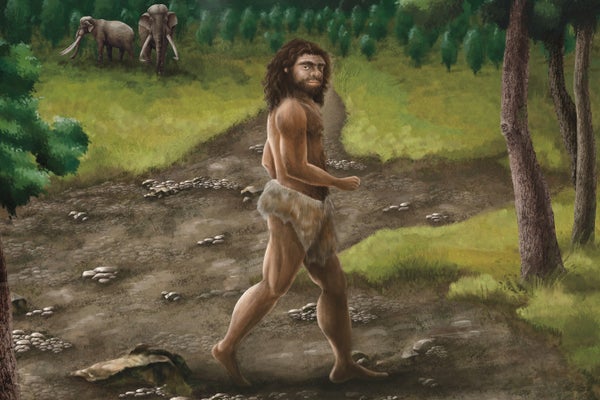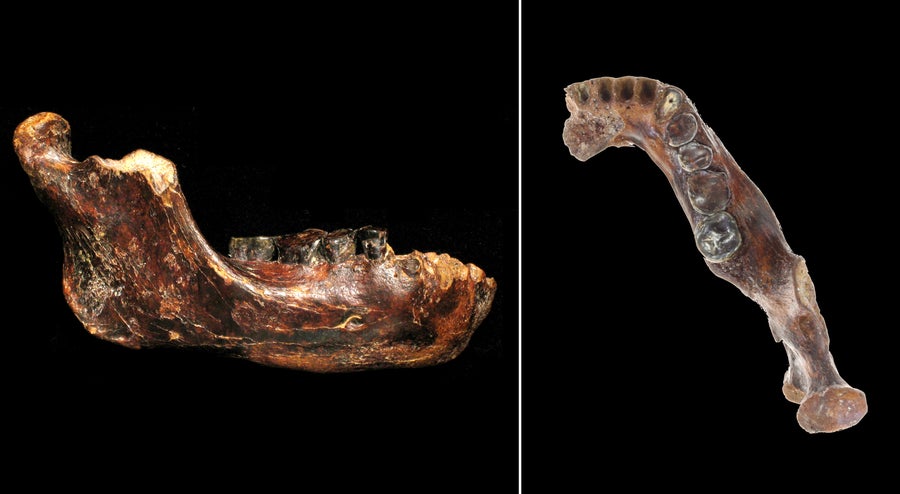Denisovan Fossil Shows Enigmatic Human Cousins Lived from Siberia to Subtropics
The third confirmed location of extinct hominins known as Denisovans shows these human cousins adapted to an impressive range of environments

Illustration of a Denisovan male walking under the bright sun of Taiwan.
A fossilized jawbone found off the coast of Taiwan nearly two decades ago belonged to a male Denisovan, scientists have found, confirming that this enigmatic group of archaic humans thrived across a vast geographic range, from Siberian snowfields to subtropical jungles. Unlike their cousins the Neandertals, however, Denisovans left behind few physical clues: this is only the third location to yield verifiable remains since their discovery 15 years ago.
The scarcity of fossils is striking because DNA evidence suggests Denisovans flourished throughout East Asia for hundreds of thousands of years. Yet scientists had no inkling of their existence until 2010, when researchers realized that a finger bone—and later some other bone fragments and teeth—from Denisova Cave in southern Siberia represented an entirely unknown branch on the hominin tree. Another decade passed before a mandible with two molars, found by a Buddhist monk in a Tibetan cave in 1980, was linked to the same elusive lineage.
“That’s very little to go on,” says Frido Welker, a molecular anthropologist at the University of Copenhagen and a co-author of the new jawbone analysis, which was published on Thursday in Science. The Siberian and Tibetan fossils revealed that Denisovans started roaming the Eurasian continent at least 200,000 years ago and survived long enough to interbreed with anatomically modern humans as the latter ventured out of Africa some 50,000 years ago. But the record is sparse enough, Welker says, that “every piece that is informative changes our picture.”
On supporting science journalism
If you’re enjoying this article, consider supporting our award-winning journalism by subscribing. By purchasing a subscription you are helping to ensure the future of impactful stories about the discoveries and ideas shaping our world today.
His team’s finding shows that not only could Denisovans endure the severe Siberian winter and the high-altitude Tibetan Plateau but that they also lived in the warm, humid climate of low-latitude East Asia. “It shows that they were extraordinarily adaptive,” says Bence Viola, a paleoanthropologist at the University of Toronto, who was not involved in this study. Besides Homo sapiens, no other hominin group—not even the hardy Neandertals—mastered such diverse environments.

Photos of the Penghu 1 mandible viewed from right side (l) and top (r).
The jawbone (formally known as Penghu 1) was hauled out of the shallow Penghu Channel, just off Taiwan’s western coast, by a commercial fishing dredge sometime before 2008 and described in a study in Nature in 2015. Its DNA was too degraded for identification. So Welker and his colleagues focused instead on proteins, complex biomolecules that take longer to break down than DNA. They found two protein variants known to be specific to Denisovans—enough to “confidently identify” the fossil, according to Janet Kelso, a computational biologist at the Max Planck Institute for Evolutionary Anthropology in Leipzig, Germany, who was not involved in this study.
For many researchers who work in this field, that confirmation comes as no surprise. “We all pretty much expected this would be a Denisovan,” Viola says, noting that its robust structure was similar to the Tibetan mandible. Plus, it wasn’t the first hint of Denisovan presence in the broader region: In 2022 a team of researchers, including Welker, reported that a molar resembling the Tibetan specimens had been found in a cave in the Annamite Mountains in Laos. But like Penghu 1, its DNA was too far gone, so there’s no conclusive evidence that it belonged to a Denisovan. It’s possible, however, that the molar could eventually be tested using Welker’s protein analysis technique.
The jawbone also adds context to what Viola calls “a bit of a mystery:” Comparisons of Denisovan DNA with that of humans today show that many of the ancient hominin’s genes live on in billions of people, from Aboriginal Australians to Native Americans. The highest rates of Denisovan DNA have been found in today’s inhabitants of the Philippines and the island of New Guinea, as well as other Pacific islands, but “it’s been kind of hard to square that with the places we have Denisovan fossils from,” Viola says. Siberia and Oceania aren’t exactly neighbors.
This new study provides another anchor point for where Denisovans and early modern humans could have met and swapped genes, says Emilia Huerta-Sánchez, a population geneticist at Brown University, who was not involved in the study. Her work has shown that several genetically distinct Denisovan populations engaged in these interhominin unions—and that some of the DNA we acquired from them offered an evolutionary advantage (for instance, by enabling Tibetans to breathe the thin air of their homeland).
The proteins in Penghu 1 don’t, however, do much to advance researchers’ understanding of gene flow between Denisovans and early modern humans, according to Huerta-Sánchez. “This is a little bit of data,” she says, but to really flesh out those ancient interactions, “it would be nice to get a whole genome from a different geographic location,” somewhere outside Siberia and Tibet. That’s an inherently difficult task, given the fragility of DNA, especially in warmer climates.
Welker says he’ll wait until more data come in to speculate on precisely how our most cryptic relatives fit into the story of human evolution. For now, the jawbone marks “a new addition to our hominin family,” as he puts it—and another breadcrumb on the trail of the Denisovans.









